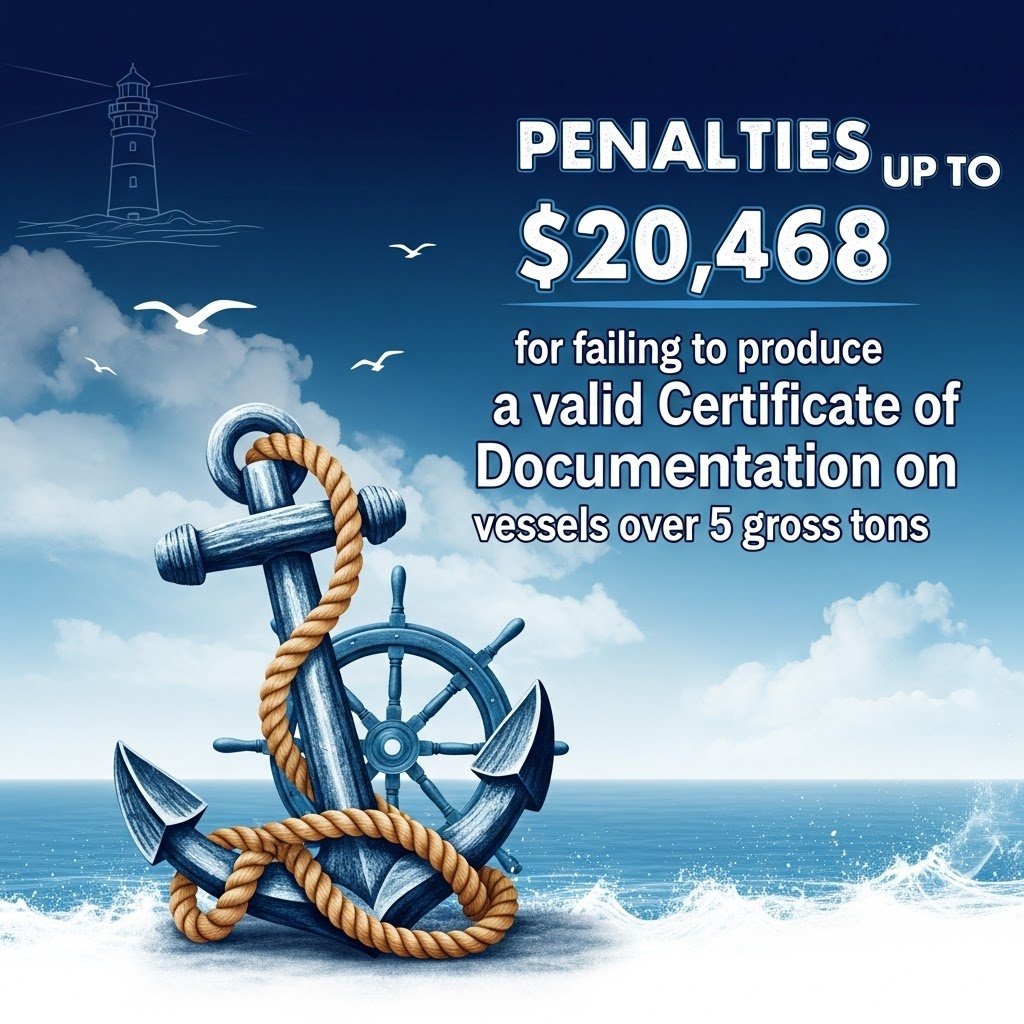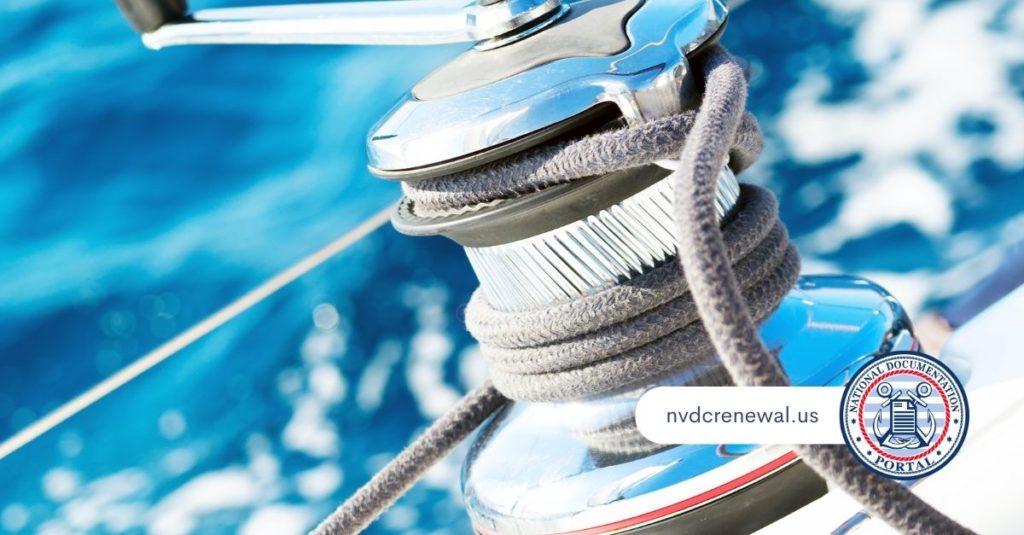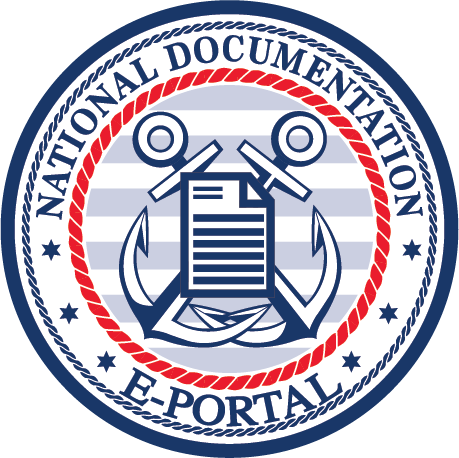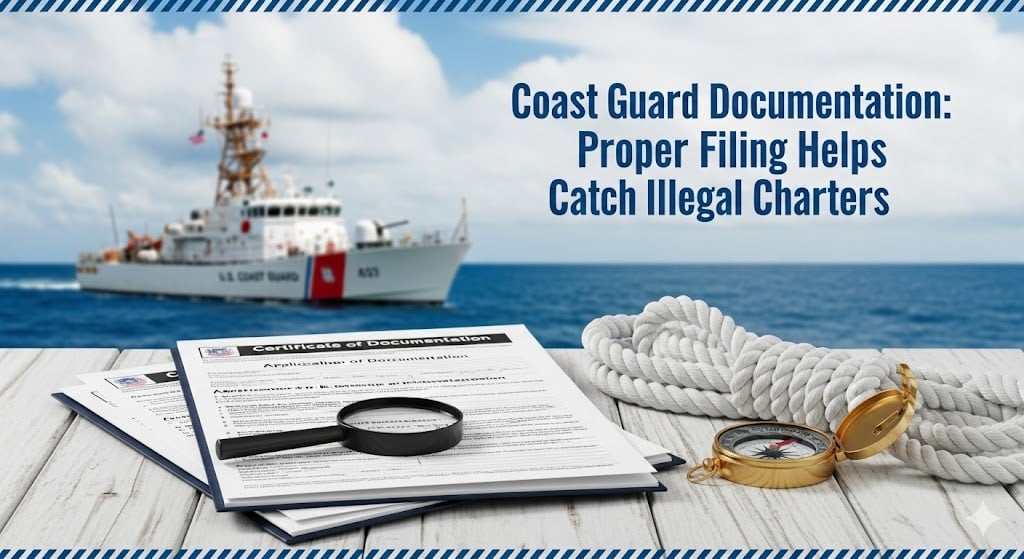When it comes to boating safety and legality, having proper Coast Guard documentation is not just bureaucratic red tape — it is a crucial safeguard.

At the National Documentation E-Portal, we make it easy to apply for and renew your USCG documentation through our online portal. With the right documentation in place, vessel operators comply with federal law — and help prevent illegal charter operations.
The Role of Coast Guard Documentation in Illegal Charter Enforcement
Recently, (as written by NBC Miami), Coast Guard Sector Miami, together with federal, state, and local partners, intervened to stop 13 illegal charter voyages on Biscayne Bay and the Miami River. Several of those vessels lacked key safety credentials.
Among the violations documented: failure to have a valid Certificate of Inspection and failure to carry properly credentialed crew.
One particularly serious issue was the lack of a Certificate of Documentation endorsed for coastwise trade — a form of Coast Guard documentation that verifies a vessel’s legal ability to operate commercially in U.S. waters.
Without that endorsement, these vessels were operating illegally as passenger-for-hire operations.
By enforcing these regulations, the Coast Guard prevented unsafe and unauthorized charter operations. This shows how completely lacking or improper Coast Guard documentation can directly trigger enforcement action.
How This Shows the Importance of Coast Guard Documentation
Ensuring that a vessel is correctly documented has many benefits — and serious legal consequences when it’s not. Here’s how our service helps, and why it’s vital:
- Proper documentation ensures your vessel meets federal requirements, especially if you’re operating commercially.
- It supports regulatory compliance: without the correct documentation, operators can’t legally run charter trips.
- It protects passengers: when documentation and inspection credentials are verified, it reduces risk to public safety.
- It helps law enforcement: documented vessels are easier to track and inspect, making it harder for illegal charter operators to slip through the cracks.
When a vessel is undocumented or improperly documented, it becomes a liability — both for the operator and for the safety of people on board.

The Consequences of Not Having Documentation
The recent Miami enforcement action underscores just how steep the penalties can be. According to the Coast Guard:
- Operators of illegal charters can face civil penalties of $69,000 or more for illegally carrying passengers for hire.
- Specific violations are costly:
- Up to $5,996 for failing to provide a valid Certificate of Inspection on vessels with more than six passengers.
- Up to $20,468 for not producing a valid Certificate of Documentation on vessels over 5 gross tons.
- For violating an active Captain of the Port (COTP) Order, the penalties are especially severe. Under 46 U.S.C. 70036, fines can reach $117,608 per day, and willful, knowing violation is a felony — up to six years in prison and fines of up to $250,000 for an individual (or $500,000 for an organization).
These numbers make one thing very clear: lacking Coast Guard documentation is not a small risk. It can lead to vessel seizures, fines, or even criminal charges.
Heroes on the Water: The Coast Guard’s Role
The Coast Guard’s intervention in Miami demonstrates its dedication to public safety and legal maritime operations. Here’s what made their response heroic and effective:
- Collaboration: Coast Guard Sector Miami didn’t act alone. Their efforts were combined with federal, state, and local law enforcement to shut down illegal charter activity.
- Proactive boardings: Officers boarded vessels such as “The Round” (a 98-foot motor yacht) and “Second Wind” (a 52-foot cabin cruiser) to enforce compliance.
- Strict legal enforcement: The Coast Guard issued violations under a variety of safety regulations: invalid registrations, missing Certificates of Inspection, missing life jackets, no drug-and-alcohol program, and uncredentialed crew.
- Public safety messaging: The Coast Guard encouraged passengers to verify credentials — urging people to ask operators for a Merchant Mariner Credential and to demand a valid Certificate of Inspection.
Their mission is both protective and preventative: protecting those on the water and preventing dangerous, illegal operations from continuing.

Coast Guard Documentation
How Our Service Makes Documentation Easy
At National Documentation E-Portal, we simplify the process of securing Coast Guard documentation. Here’s how we help:
- We offer an intuitive online portal to apply for initial documentation or documented vessel renewal, saving you time and reducing paperwork.
- We guide you through gathering and submitting required forms (e.g., vessel ownership, tonnage, gross tons).
- We help you avoid costly mistakes so that your documentation is valid, current, and compliant with U.S. Coast Guard standards.
By using our service, you reduce the risk of noncompliance. That not only protects your operation — it aligns with the Coast Guard’s mission to keep boating safe.
Different Documentation Forms and Their Importance
Documenting your vessel is one thing. You want to have the right forms beyond that initial documentation, too. Knowing which forms you need and why can make a big difference.
- Certificate of Documentation Lookup: This is a way to verify whether your vessel is properly documented — something charter clients or inspectors may check.
- Preferred Ship Mortgage: If you’re financing your vessel, having a certificate of documentation can allow you to use it as security for a preferred ship mortgage.
- Abstract of Title: This document shows a vessel’s ownership history, liens, and encumbrances — often used in legal or financial transactions involving a documented vessel.
Each of these items and many others may be just what you need. Missing any one of them can undermine your compliance and open the door to penalties.
Strengthening Compliance Through Documentation
By partnering with us at National Documentation E-Portal, you’re not just avoiding fines — you’re actively contributing to safer, more lawful maritime operations. Here’s how proper Coast Guard documentation strengthens compliance:
- It makes inspections easier: documented vessels are more straightforward to audit and board for law enforcement.
- It enhances trust: properly documented vessels can more easily operate in commercial passenger-for-hire services, improving credibility with charter clients.
- It deters illegal operations: when proper documentation becomes the norm, unlicensed or unsafe charters become more difficult to operate without risk.
- It supports accountability: documented vessels have legal records, which can be traced through certificates, endorsements, and titles.
In the case of Sector Miami, documentation gaps directly led to enforcement. But with correct documentation, vessel owners demonstrate they are operating with legitimacy.
Every vessel owner has a responsibility — to their passengers, to themselves, and to the law. Proper documentation helps you live up to that responsibility. Use our portal today to apply, renew, or verify your status.
Let us make Coast Guard documentation simple and secure — and help you avoid the very real penalties that the Coast Guard just enforced on those illegal charters.

